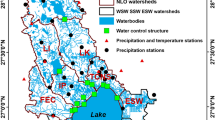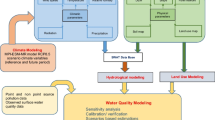Abstract
The outputs from two General Circulation Models (GCMs) with two emissions scenarios were downscaled and bias-corrected to develop regional climate change projections for the Tahoe Basin. For one model—the Geophysical Fluid Dynamics Laboratory or GFDL model—the daily model results were used to drive a distributed hydrologic model. The watershed model used an energy balance approach for computing evapotranspiration and snowpack dynamics so that the processes remain a function of the climate change projections. For this study, all other aspects of the model (i.e. land use distribution, routing configuration, and parameterization) were held constant to isolate impacts of climate change projections. The results indicate that (1) precipitation falling as rain rather than snow will increase, starting at the current mean snowline, and moving towards higher elevations over time; (2) annual accumulated snowpack will be reduced; (3) snowpack accumulation will start later; and (4) snowmelt will start earlier in the year. Certain changes were masked (or counter-balanced) when summarized as basin-wide averages; however, spatial evaluation added notable resolution. While rainfall runoff increased at higher elevations, a drop in total precipitation volume decreased runoff and fine sediment load from the lower elevation meadow areas and also decreased baseflow and nitrogen loads basin-wide. This finding also highlights the important role that the meadow areas could play as high-flow buffers under climatic change. Because the watershed model accounts for elevation change and variable meteorological patterns, it provided a robust platform for evaluating the impacts of projected climate change on hydrology and water quality.






Similar content being viewed by others
References
Abbott MR, Denman KL, Powell TM, Richerson PJ, Richards RC, Goldman CR (1984) Mixing and the dynamics of the deep chlorophyll maximum in Lake Tahoe. Limnol Oceanogr 29:862–878
Anderson ML, Chen Z-Q, Kavvas ML, Feldman A (2002) Coupling HEC-HMS with atmospheric models for prediction of watershed runoff. J Hydrol Eng 7(4):312–318
Betts RA, Bourcher O, Collins M, Cox P, Falloon P, Nicola G, Hemming D, Huntingford C, Jones C, Sexton D, Webb M (2007) Projected increase in continental runoff due to plant responses to increasing carbon dioxide. Nature 448:1037–1041
Bicknell BR, Imhoff JC, Kittle JL, Donigan AS Jr, Johanson RC (1997) Hydrological Simulation Program - FORTRAN, User’s Manual for Version 11. U.S. Environmental Protection Agency, Athens
Coats R, Reuter J, Dettinger M, Riverson J, Sahoo G, Schladow G, Wolfe B, Costa-Cabral M (2010) The effects of climate change on Lake Tahoe in the 21st century: Meteorology, hydrology, loading and lake response. Report for Jonathan Long, Pacific Southwest Research Station, Tahoe Environmental Science Center, Incline Village, NV, USA. http://terc.ucdavis.edu/publications/P030Climate_Change_Project_Final_Report_2010.pdf
Coats R, Costa-Cabral M, Riverson J, Reuter J, Sahoo G, Schladow G, Wolfe B (2012) Projected 21st century trends in hydroclimatology of the Tahoe basin. This special issue.
Costa-Cabral M, Roy S, Maurer EP, Mills WB, Chen L (2012) Snowpack and runoff response to climate change in Owens Valley and Mono Lake watersheds. Clim Chang, this special issue. doi:10.1007/s10584-012-0529
Crawford NH, Linsley RK (1966) Digital Simulation in Hydrology, Stanford Watershed Model 4. Stanford University, Stanford
Das T, Dettinger MD, Cayan DR, Hidalgo HG (2011) Potential increase in floods in California’s Sierra Nevada under future climate projections. Clim Chang. doi:10.1007/s10584-011-0298-z
Delworth TL et al (2006) GFDL’s CM2 global coupled climate models. Part 1: Formulation and simulation characteristics. J Climate 19(5):643–674
Dettinger M (2012) Projections and downscaling of 21st century temperatures, precipitation, radiative fluxes and winds for the Southwestern US, with focus on the Lake Tahoe Basin. This special issue.
Dettinger MD, Cayan DR, Meyer MK, Jeton AE (2004) Simulated hydrologic responses to climate variations and change in the Merced, Carson, and American River Basins, Sierra Nevada, California, 1900-2009. Clim Chang 62:283–317
Elsner ME, Cuo L, Voisin N, Deems JS, Hamlet AF, Vano JA, Mickelson K, Lee S-Y, Lettenmaier DP (2010) Implications of 21st century climate change for the hydrology of Washington State. Clim Chang 102:225–260
Hawkins E, Sutton R (2009) The potential to narrow uncertainty in regional climate predictions. Bull Amer Meteor Soc 90:1095–1107
Heyvaert A, Reuter JE, Thomas J, Schladow SG (2007) Particle Size Distribution in Stormwater Runoff Samples at Tahoe. Technical Memo dated March 2, 2007. Prepared for Lahontan Regional Water Quality Control Board by Desert Research Institute and UC Davis – Tahoe Environmental Research Center.
Hidalgo HG, Dettinger MD, Cayan DR (2008) Downscaling with Constructed Analogues: Daily Precipitation and Temperature Fields Over the United States. California Climate Change Center, p. 48.
Jassby AD, Reuter JE, Goldman CR (2003) Determining long-term water quality change in the presence of climatic variability, Lake Tahoe (USA). Can Jour Fish Aquat Sci 60:1452–1461
Johnson TE, Butcher JB, Parker A, Weaver CP (2012) Investigating the sensitivity of U.S. streamflow and water quality to climate change: U.S. EPA Global Change Research Program’s 20 Watersheds Project. J Water Resour Plann Manage 138:453–464
Leakey ADB, Ainsworth EA, Bernacchi CJ, Rogers A, Long SP, Ort DR (2009) Elevated CO2 effects on plant carbon, nitrogen, and water relations: six important lessons from FACE. Jour Exp Botany 60:2859–2876
LWRQCB, NDEP (2010) Lake Tahoe Total Maximum Daily Load Technical Report. Lahontan Regional Water Quality Control Board, South Lake Tahoe, California, and Nevada Division of Environmental Protection, Carson City, Nevada, Carson City, NV, p. 340 pp.
Maurer E, Duffy P (2005) Uncertainty in projections of streamflow changes due to climate change in California. Geophys Res Ltt 32:L03704
Meehl GA, Covey C, Delworth T, Latif M, McAvaney B, Mitchell JFB, Stouffer RJ, Taylor KE (2007) The WCRP CMIP3 multimodel dataset: A new era in climate change research. Bul Am Meterol Soc 88:1383–1394
Mote P, Brekke L, Duffy PB, Maurer E (2011) Guidelines of constructing climate change scenarios. EOS: Trans Am Geophy Union 92:257
Nakicenovic N et al (2000) Special report on emissions scenarios. Cambridge Univ. Press, Cambridge
Penman HL (1948) Natural evaporation from open water, bare soil, and grass. P Roy Soc London A 193:120–145
Pierce DW, Barnett TP, Santer B, Gleckler P (2009) Selecting global climate models for regional climate change studies. Proc Nat Academy Sci 106:8441–8446
Riverson J, Barreto C, Shoemaker L, Reuter J, Roberts D (2005) Development of the Lake Tahoe watershed model: lessons learned through modeling in a subalpine environment. World Water and Environmental Resource Congress – 2005, Anchorage, Alaska.
Roberts D, Reuter J (2007) Lake Tahoe Total Maximum Daily Load Technical Report California and Nevada. Lahontan Regional Water Quality Control Board and Nevada Division of Ennvironmental Protection, South Lake Tahoe
Rowe TG, Saleh DK, Watkins SA, Kratzer CR (2002) Streamflow and Water-Quality Data for Selected Watersheds in the Lake Tahoe Basin, California and Nevada, through September 1998. U.S. Geological Survey Water-Resource Investigation (WRI 02-4030). U.S. Geological Survey, Carson City
Sahoo GB, Schladow SG, Reuter JE, Coats RN, Dettinger M, Riverson J, Wolfe B, Costa-Cabral M (2012) The response of Lake Tahoe to climate change. This special issue.
Shen J, Parker A, Riverson J (2005) A new approach for a Windows-based watershed modelling system based on a database-supporting architecture. Jour Environ Modelling and Software 20:1127–1138
Simon A, Langendoen EJ, Bingner RL, Wells R, Heins A, Jokay N, Jaramillo I (2003) Lake Tahoe Basin Framework Implementation Study: Sediment Loadings and Channel Erosion. U.S. Department of Agriculture, Agricultural Research Service, National Sedimentation Laboratory.
Slotto RA, Crouse MY (1996) HYSEP: A Computer Program for Streamflow Hydrograph Separation and Analysis. U.S. Geological Survey.
Smith D, Kuschnicki J (2009) Lake Tahoe Total Maximum Daily Load. Lahontan Regional Water Quality Control Board and Nevada Division of Ennvironmental Protection, South Lake Tahoe
Stewart IT, Cayan D, Dettinger M (2004) Changes in snowmelt runoff timing in western North America under a “business as usual” climate change scenario. Clim Chang 62:217–232
Tetra Tech (2007) Watershed Hydrologic Modeling and Sediment and Nutrient Loading Estimation for the Lake Tahoe Total Maximum Daily Load. Final Modeling Report. Prepared for the Lahontan Regional Water Quality Control Board and University of California, Davis
Wood AW, Maurer EP, Kumar A, Lettenmaier DP (2002) Long-range experimental hydrologic forecasting for the eastern United States. J Geophys Res 107:4429. doi:4410.1029/2001JD000659
Wood AW, Leung LR, Sridhar V, Lettenmaier DP (2004) Hydrologic implications of dynamical and statistical approaches to downscaling climate model outputs. Clim Chang 62:189–216
Zou GY, Donner A (2008) Construction of confidence limits about effect measures: A general approach. Statistics in Medicine 27:1693–1702
Acknowledgements
The Tahoe Climate Change Project was supported by grant #08-DG-11272170-101 from the USDA Forest Service Pacific Southwest Research Station using funds provided by the Bureau of Land Management through the sale of public lands as authorized by the Southern Nevada Public Land Management Act. We thank Jonathan Long for his patience and administrative help.
Author information
Authors and Affiliations
Corresponding author
Additional information
This article is part of a Special Issue on Climate Change and Water Resources in the Sierra Nevada edited by Robert Coats, Iris Stewart, and Constance Millar
Electronic supplementary material
Below is the link to the electronic supplementary material.
Online Resource 1
(DOC 30 kb)
Online Resource 2
(DOC 53 kb)
Online Resource 3
(DOC 2448 kb)
Online Resource 4
(DOC 340 kb)
Online Resource 5
(DOC 6092 kb)
Rights and permissions
About this article
Cite this article
Riverson, J., Coats, R., Costa-Cabral, M. et al. Modeling the transport of nutrients and sediment loads into Lake Tahoe under projected climatic changes. Climatic Change 116, 35–50 (2013). https://doi.org/10.1007/s10584-012-0629-8
Received:
Accepted:
Published:
Issue Date:
DOI: https://doi.org/10.1007/s10584-012-0629-8




